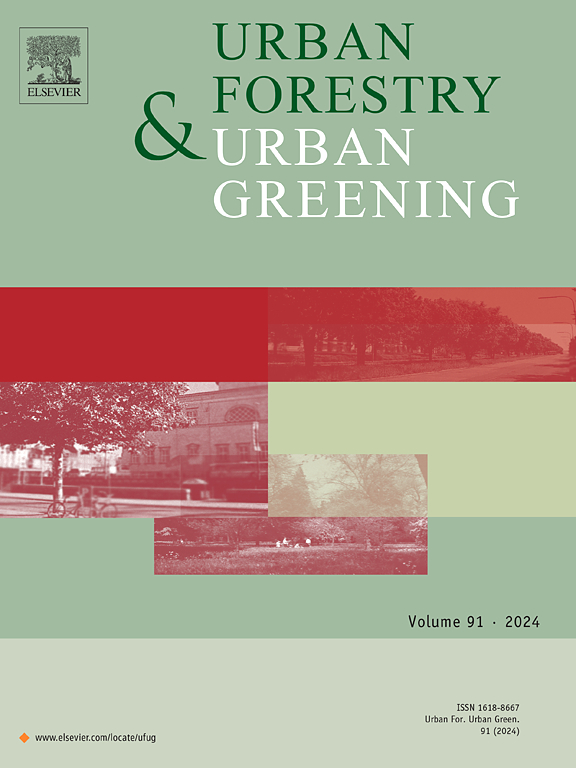How do economic levels, urbanization, and infrastructure investments influence inequality in urban green space exposure? Insights from Japanese municipalities
IF 6
2区 环境科学与生态学
Q1 ENVIRONMENTAL STUDIES
引用次数: 0
Abstract
Urban green spaces (UGS) are vital for urban sustainability, but unequal exposure to UGS can lead to serious health inequalities. The long-term drivers of inequalities in personal exposure to UGS and the underlying mechanisms remain insufficiently understood. This study measures trends in inequality in UGS exposure in 710 Japanese municipalities over a 20-year period (2000–2020). The direct and indirect effects of economic status, urbanization, and infrastructure investments on inequalities in UGS exposure were analyzed using partial least squares structural equation modeling while considering the mediating roles of land use, demographic, and greening factors. This study found that the distributional inequality in UGS exposure in Japanese municipalities has increased significantly over the past two decades. Economic levels, urbanization, and infrastructure investments drive UGS exposure inequality directly and indirectly through greening and population density. While these relationships may vary by period and region, UGS and population density remain key predictors. Given Japan's challenges related to population decline and aging, cities need to focus on population dynamics and the distribution and size of UGS based on specific economic conditions and stages of urbanization to formulate effective strategies for sustainable development.
经济水平、城市化和基础设施投资如何影响城市绿地暴露的不平等?来自日本市政当局的启示
城市绿地对城市的可持续性至关重要,但对城市绿地的不平等暴露可能导致严重的健康不平等。个人接触UGS不平等的长期驱动因素及其潜在机制仍未得到充分了解。本研究测量了20年间(2000-2020年)日本710个城市UGS暴露的不平等趋势。利用偏最小二乘结构方程模型分析了经济状况、城市化和基础设施投资对UGS暴露不平等的直接和间接影响,同时考虑了土地利用、人口和绿化因素的中介作用。本研究发现,在过去二十年中,日本城市UGS暴露的分配不平等显著增加。经济水平、城市化和基础设施投资通过绿化和人口密度直接或间接地推动UGS暴露不平等。虽然这些关系可能因时期和地区而异,但UGS和人口密度仍然是关键的预测指标。鉴于日本面临的人口下降和老龄化的挑战,城市需要根据具体的经济条件和城市化阶段,关注人口动态和UGS的分布和规模,制定有效的可持续发展战略。
本文章由计算机程序翻译,如有差异,请以英文原文为准。
求助全文
约1分钟内获得全文
求助全文
来源期刊

Urban Forestry & Urban Greening
FORESTRY-
CiteScore
11.70
自引率
12.50%
发文量
289
审稿时长
70 days
期刊介绍:
Urban Forestry and Urban Greening is a refereed, international journal aimed at presenting high-quality research with urban and peri-urban woody and non-woody vegetation and its use, planning, design, establishment and management as its main topics. Urban Forestry and Urban Greening concentrates on all tree-dominated (as joint together in the urban forest) as well as other green resources in and around urban areas, such as woodlands, public and private urban parks and gardens, urban nature areas, street tree and square plantations, botanical gardens and cemeteries.
The journal welcomes basic and applied research papers, as well as review papers and short communications. Contributions should focus on one or more of the following aspects:
-Form and functions of urban forests and other vegetation, including aspects of urban ecology.
-Policy-making, planning and design related to urban forests and other vegetation.
-Selection and establishment of tree resources and other vegetation for urban environments.
-Management of urban forests and other vegetation.
Original contributions of a high academic standard are invited from a wide range of disciplines and fields, including forestry, biology, horticulture, arboriculture, landscape ecology, pathology, soil science, hydrology, landscape architecture, landscape planning, urban planning and design, economics, sociology, environmental psychology, public health, and education.
 求助内容:
求助内容: 应助结果提醒方式:
应助结果提醒方式:


